|
|
 |
Baked Pumpkin Cheesecake—Prototype 1:
Crust:
2 oz. melted, white chocolate
2 oz. pumpkin butter (such as from Trader Joe's)
4 oz. whipped lowfat cottage cheese, no salt added
1/4 cup skim milk
2 tablespoons granulated sugar
1/2 teaspoon vanilla
2.2 oz. Bran Buds, ground up
Batter:
2 tablespoons melted or softened butter
3 oz. pumpkin butter
1/2 cup skim milk
1/2 cup granulated sugar
1/4 cup flour
1/4 teaspoon salt
2 cups whipped lowfat cottage cheese, no salt added
2 eggs
Bake at 300 degrees for about 110 minutes (with tub immersion), or until
cake tester comes clean.
Baked Pumpkin Cheesecake—Prototype 2:
Repeat Prototype 1, but boost the batter's pumpkin butter by 1 ounce, to 4
ounces.
Baked Pumpkin Cheesecake—Prototype 3:
Crust:
2 oz. melted, white chocolate
2 oz. pumpkin butter (such as from Trader Joe's)
1 cup (8 oz.) whipped lowfat cottage cheese, no salt added
1/4 cup skim milk
1 teaspoon lemon juice
2 tablespoons granulated sugar
2 tablespoons brown sugar
1/2 teaspoon vanilla
2.2 oz. Bran Buds, ground up
Pour this crust mixture into a 9" pan and pre-bake this at 300 degrees
(without tub) for 20 minutes. Then cool this off until the pan is
comfortable enough to touch.
Batter:
2 tablespoons melted or softened butter
5/8 cup granulated sugar
6 oz. pumpkin butter
1 tablespoon lemon juice
1/2 cup skim milk
1/2 cup flour
1/4 teaspoon salt
3 cups (24 oz.) whipped lowfat cottage cheese, no salt added
2 eggs
Bake at 300 degrees (with tub) for 2 hours.
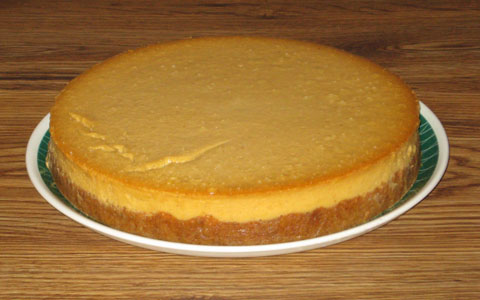
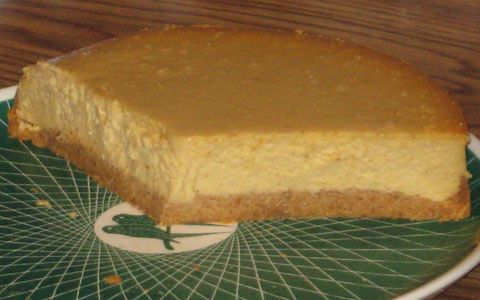
Baked Pumpkin Cheesecake—Prototype 4:
2-to-1 Blend of Yogurt Cheese and Cottage Cheese:
Prepare ahead of time 16 ounces of yogurt cheese, derived from one 32-ounce
container of nonfat yogurt. If the resulting yogurt cheese falls below 16
ounces, add back enough of the whey (that was strained out from the yogurt) to
make up the difference. To this yogurt cheese combine 8 ounces (1 cup) of
whipped, lowfat cottage cheese.
Crust:
1 oz. melted, white chocolate
2 oz. pumpkin butter (such as from Trader Joe's)
1 tablespoon granulated sugar
1 tablespoon brown sugar
1/4 teaspoon vanilla
4 oz. (1/2 cup) 2-to-1 blend of yogurt cheese and cottage cheese (see above)
1.1 oz. Bran Buds, ground up
Pour this crust mixture into pan (9 to 9 1/2 inches) and pre-bake without tub at
300 degrees for 5 minutes, then cool enough to comfortably touch at least the
pan's upper sidewall.
Batter:
2 tablespoons melted or softened butter
1/2 cup granulated sugar
7 oz. pumpkin butter
1/3 cup all-purpose flour
1/4 teaspoon salt
2 1/2 cups (20 oz.) 2-to-1 blend of yogurt cheese and cottage cheese (see above)
1 teaspoon vanilla
2 eggs
Pour on top of crust. Then bake in tub at 300 degrees for 60 minutes (if using a
9 1/2" pan), cool (outside of oven and tub) for an hour, remove from pan
and refrigerate.
Baked Pumpkin Cheesecake—Prototype 5:
2-to-1 Blend of Yogurt Cheese and Cottage Cheese:
Prepare ahead of time 2 pounds of yogurt cheese, derived from two 32-ounce
containers of nonfat yogurt. If the resulting yogurt cheese falls below 32
ounces, add back enough of the whey (that was strained out from the yogurt) to
make up the difference. To this yogurt cheese combine 16 ounces (1 pint) of
whipped, lowfat cottage cheese.
Crust:
2 oz. melted, white chocolate
4 oz. pumpkin butter (such as from Trader Joe's)
2 tablespoons granulated sugar
2 tablespoons brown sugar
1/2 teaspoon vanilla
8 oz. (1 cup) 2-to-1 blend of yogurt cheese and cottage cheese (see above)
2.2 oz. Bran Buds, ground up
Pour this crust mixture into pan (9 to 9 1/2 inches) and pre-bake without tub at
300 degrees for 10 minutes, then cool enough to comfortably touch at least the
pan's upper sidewall.
Batter:
4 tablespoons melted or softened butter
1 cup granulated sugar
14 oz. pumpkin butter
1/4 cup all-purpose flour
3 tablespoons arrowroot
1/2 teaspoon salt
5 cups (40 oz.) 2-to-1 blend of yogurt cheese and cottage cheese (see above)
2 teaspoons vanilla
4 eggs
Pour on top of crust. Bake in tub at 300 degrees for 105 minutes (if using a 9
1/2" pan). Then cool down while still in oven (with this oven shut off) and
in tub with door slightly ajar for an hour. Afterwards, remove from oven and tub
and continue to cool down at room temperature for another 105 minutes, then
remove from pan and refrigerate.
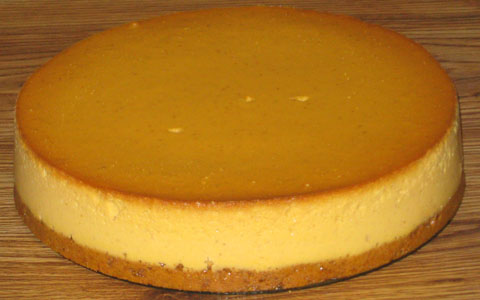
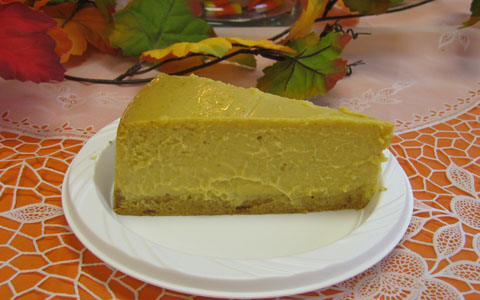
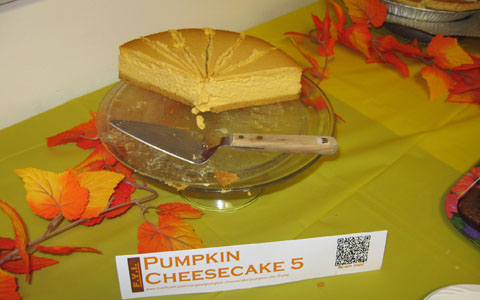
Baked Pumpkin Cheesecake—Prototype 6:
2-to-1 Blend of Yogurt Cheese and Cottage Cheese:
Prepare ahead of time 2 pounds of yogurt cheese, derived from two 32-ounce
containers of nonfat yogurt. If the resulting yogurt cheese falls below 32
ounces, add back enough of the whey (that was strained out from the yogurt) to
make up the difference. To this yogurt cheese combine 16 ounces (1 pint) of
whipped, lowfat cottage cheese.
Crust:
2 oz. melted, white chocolate
4 oz. pumpkin butter (such as from Trader Joe's)
2 tablespoons granulated sugar
2 tablespoons brown sugar
1/2 teaspoon vanilla
8 oz. (1 cup) 2-to-1 blend of yogurt cheese and cottage cheese (see above)
2 oz. All-Bran, ground up
Pour this crust mixture into pan (9 to 9 1/2 inches) and pre-bake without tub at
300 degrees for 10 minutes, then cool enough to comfortably touch at least the
pan's upper sidewall.
Batter:
4 tablespoons melted or softened butter
1 cup granulated sugar
14 oz. pumpkin butter
1/4 cup all-purpose flour
3 tablespoons arrowroot
5 cups (40 oz.) 2-to-1 blend of yogurt cheese and cottage cheese (see above)
2 teaspoons vanilla
4 eggs
Pour on top of crust. Bake in tub at 300 degrees for 105 minutes (if using a 9
1/2" pan). Then cool down while still in oven (with this oven shut off) and
in tub with door slightly ajar for an hour. Afterwards, remove from oven and tub
and continue to cool down at room temperature for another 105 minutes, then
remove from pan and refrigerate.
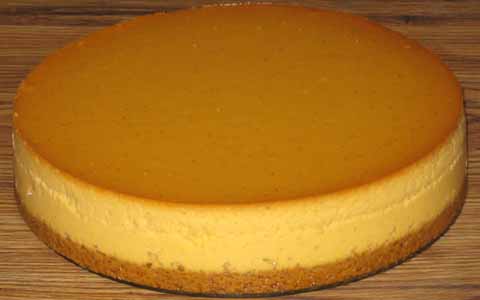
Baked Pumpkin Cheesecake—Prototype 7:
3-Cheese Blend (1CT-1NC-4YG):
Prepare ahead of time 32 ounces of yogurt cheese, derived from two 32-ounce
containers (that's 64 ounces altogether) of nonfat yogurt. If the resulting
yogurt cheese falls below 32 ounces, add back enough of the whey (that was
strained out from the yogurt) to make up the difference. To this yogurt cheese
combine 8 ounces of whipped, lowfat cottage cheese and 8 ounces of softened
Neufchatel cheese ("light cream cheese").
Crust:
2 oz. melted, white chocolate
4 oz. pumpkin butter (such as from Trader Joe's)
2 tablespoons granulated sugar
2 tablespoons brown sugar
1/2 teaspoon vanilla
8 oz. (1 cup) 3-cheese blend (see above)
2 oz. All-Bran, ground up
Place the resulting mixture in a greased 9 1/2" (or 9") pan and
pre-bake without tub at 300 degrees for 5-10 minutes, depending on the mixture's
thickness (closer to 10 minutes if thin enough to be fully distributed across
the pan's bottom by gentle shaking, closer to 5 minutes if thick enough to
require spreading out this mixture by pressing on it with a utensil and/or
fingers), then cool enough to comfortably touch at least the pan's upper
sidewall.
Batter:
1 cup granulated sugar
14 oz. pumpkin butter
40 oz. (5 cups) 3-cheese blend (see above)
1/4 cup + 1 tablespoon (5 tablespoons altogether) arrowroot
2 teaspoons vanilla
5 eggs
Wrap the pan in foil at this point (no earlier, for the sake of minimal foil
disturbance), then pour the batter on top of the crust. Bake in hot water tub at
300 degrees for 105 to 115 minutes (if using a 9 1/2" pan—also see
comments below). Then cool down while still in oven (with this oven shut off)
and in tub with door slightly ajar for an hour. Afterwards, remove from oven
and tub and continue to cool down at room temperature for another 105 to 115
minutes (see comments below), then remove from pan and refrigerate.
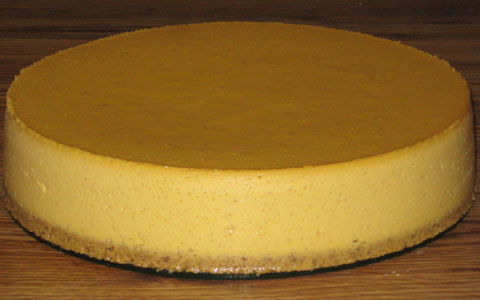
Baked Pumpkin Cheesecake—Prototype 8:
3-Cheese Blend (3CT-1NC-2YG):
Prepare ahead of time 16 ounces of yogurt cheese, derived from one 32-ounce
container of nonfat yogurt. If the resulting yogurt cheese falls below 16
ounces, add back enough of the whey (that was strained out from the yogurt) to
make up the difference. To this yogurt cheese combine 24 ounces of whipped,
lowfat cottage cheese and 8 ounces of softened Neufchatel cheese ("light
cream cheese").
Grease a 9 1/2" (or 9") springform pan, but do not wrap foil around it
yet (see below).
Crust:
2 oz. melted, white chocolate
4 oz. pumpkin butter (such as from Trader Joe's)
8 oz. (1 cup) 3-cheese blend (see above)
2 tablespoons granulated sugar
2 tablespoons brown sugar
1/2 teaspoon vanilla
2 oz. All-Bran, ground up
Place the resulting mixture in the greased pan and pre-bake without tub at 300
degrees for 5-10 minutes, depending on the mixture's thickness (closer to 10
minutes if thin enough to be fully distributed across the pan's bottom by gentle
shaking, closer to 5 minutes if thick enough to require spreading out this
mixture by pressing on it with a utensil and/or fingers), then cool enough to
comfortably touch at least the pan's upper sidewall.
Batter:
1 cup granulated sugar
40 oz. (5 cups) 3-cheese blend (see above)
14 oz. pumpkin butter
2 teaspoons vanilla
1 1/2 teaspoons xanthan gum
6 eggs
Wrap the pan in foil just before adding the batter (to minimize the foil's
disturbance and therefore its leakage risk, do not put it on any earlier).
Next, carefully pour the batter over the crust and bake this cheesecake in a hot
water tub at 300 degrees for 90 minutes (if using a 9 1/2" pan). Then shut
off oven and cool cheesecake down while still in it (and in tub), with door
slightly ajar, for an hour. Afterwards, remove from oven and tub and (at this
point, add a border of chips—such as pumpkin-flavored—if desired)
continue to cool down at room temperature for another two hours, then remove
from pan and refrigerate.
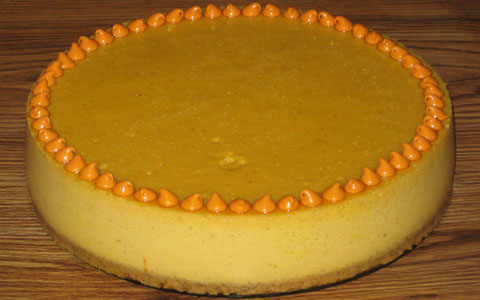
Baked Pumpkin Cheesecake—Prototype 9:
3-Cheese Blend (3CT-1NC-2YG):
Prepare ahead of time 16 ounces of yogurt cheese, derived from one 32-ounce
container of nonfat yogurt. If the resulting yogurt cheese falls below 16
ounces, add back enough of the whey (that was strained out from the yogurt) to
make up the difference. To this yogurt cheese combine 24 ounces of whipped,
lowfat cottage cheese and 8 ounces of softened Neufchatel cheese ("light
cream cheese").
Grease a 9 1/2" (or 9") springform pan, but do not wrap foil around it
yet (see below).
Crust:
2 oz. melted, white chocolate
4 oz. pumpkin butter (such as from Trader Joe's)
8 oz. (1 cup) 3-cheese blend (see above)
2 tablespoons granulated sugar
2 tablespoons brown sugar
1/2 teaspoon vanilla
2 oz. All-Bran, ground up
Place the resulting mixture in the greased pan and pre-bake without tub at 300
degrees for 15 minutes (if the crust is extremely thick however, closer to 10
minutes might be sufficient—on the other hand, the mixture is a lot more
likely to be thin enough to require a good 15 minutes), then cool enough to
comfortably touch at least the pan's upper sidewall.
Batter:
1 cup granulated sugar
40 oz. (5 cups) 3-cheese blend (see above)
14 oz. pumpkin butter
2 teaspoons vanilla
1 3/4 teaspoons xanthan gum
6 eggs
Wrap the pan in foil just before adding the batter (to minimize the foil's
disturbance and therefore its leakage risk, do not put it on any earlier).
Next, carefully pour the batter over the crust and bake this cheesecake in a hot
water tub at 300 degrees for 105 minutes (if using a 9 1/2" pan). Then shut
off oven and cool cheesecake down while still in it (and in tub), with door
slightly ajar, for an hour. Afterwards, remove from oven and tub and (at this
point, add a border of chips—such as pumpkin-flavored—if desired)
continue to cool down at room temperature for another two hours, then remove
from pan and refrigerate.
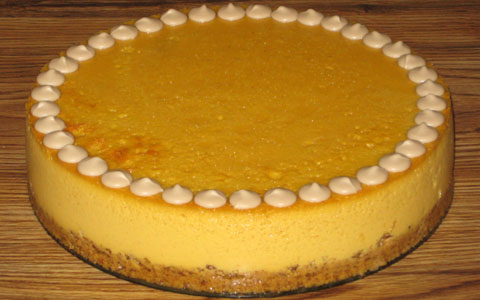
Baked Pumpkin Cheesecake—Prototype 10:
3-Cheese Blend (3CT-1NC-2YG):
Prepare ahead of time 16 ounces of yogurt cheese, derived from one 32-ounce
container of nonfat yogurt. If the resulting yogurt cheese falls below 16
ounces, add back enough of the whey (that was strained out from the yogurt) to
make up the difference. To this yogurt cheese combine 24 ounces of whipped,
lowfat cottage cheese and 8 ounces of softened Neufchatel cheese ("light
cream cheese").
Grease a 9 1/2" (or 9") springform pan, but do not wrap foil around it
yet (see below).
Crust:
2 oz. melted, white chocolate
4 oz. pumpkin butter (such as from Trader Joe's)
8 oz. (1 cup) 3-cheese blend (see above)
2 tablespoons granulated sugar
2 tablespoons brown sugar
1/2 teaspoon vanilla
2 oz. All-Bran, ground up
Place the resulting mixture in the greased pan and pre-bake without tub at 300
degrees for 20 minutes (if the crust is extremely thick however, closer to 15
minutes might be sufficient—on the other hand, the mixture is a lot more
likely to be thin enough to require a good 20 minutes), then cool enough to
comfortably touch at least the pan's upper sidewall.
Batter:
1 cup granulated sugar
40 oz. (5 cups) 3-cheese blend (see above)
14 oz. pumpkin butter
2 teaspoons vanilla
2 teaspoons xanthan gum
6 eggs
Wrap the pan in foil just before adding the batter (to minimize the foil's
disturbance and therefore its leakage risk, do not put it on any earlier).
Next, carefully pour about 2/3 of this batter over the crust and place
the pan in a hot water tub and bake in oven at 300 degrees for 85 minutes (if
using a 9 1/2" pan). Afterwards, remove this from oven and carefully
add the remaining 1/3 batter on top of the earlier installment. Return all this
to oven and continue baking at 300 degrees for another 95 minutes. Then shut
off oven and cool cheesecake down while still in it (and in tub), with door
slightly ajar, for an hour. Next, remove the pan of cheesecake from oven and
tub and (at this point, add a border of chips—such as
pumpkin-flavored—if desired) continue to cool down at room temperature
for another two hours, then remove the cheesecake from its pan and
refrigerate.
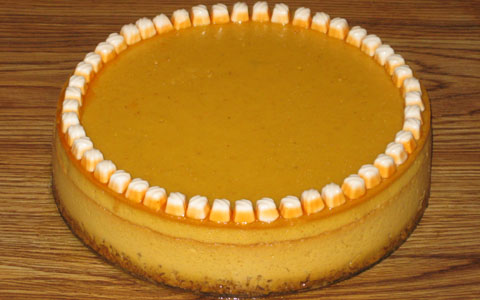
Baked Pumpkin Cheesecake—Prototype 11:
3-Cheese Blend (1CT-1NC-1YG):
Prepare ahead of time 16 ounces of yogurt cheese, derived from one 32-ounce
container of nonfat yogurt. If the resulting yogurt cheese falls below 16
ounces, add back enough of the whey (that was strained out from the yogurt) to
make up the difference. To this yogurt cheese combine 16 ounces of whipped,
lowfat cottage cheese and 16 ounces (two 8-ounce packages) of softened
Neufchatel cheese ("light cream cheese").
Grease a 9 1/2" (or 9") springform pan, but do not wrap foil around it
yet (see below).
Crust:
2 oz. melted, white chocolate
4 oz. pumpkin butter (such as from Trader Joe's)
8 oz. (1 cup) 3-cheese blend (see above)
2 tablespoons granulated sugar
2 tablespoons brown sugar
1/2 teaspoon vanilla
2 oz. All-Bran, ground up
Place the resulting mixture in the greased pan and pre-bake without tub at 300
degrees for 25 minutes, then cool enough to comfortably touch at least the
pan's upper sidewall.
Batter:
1 cup granulated sugar
40 oz. (5 cups) 3-cheese blend (see above)
14 oz. pumpkin butter
2 teaspoons vanilla
2 teaspoons xanthan gum
6 eggs
Wrap the pan in foil just before adding the batter (to minimize the foil's
disturbance and therefore its leakage risk, do not put it on any earlier).
Next, carefully pour about 2/3 of this batter over the crust and place
the pan in a hot water tub and bake in oven at 300 degrees for 55 minutes* (if
using a 9 1/2" pan). Afterwards, remove this from oven and carefully
add the remaining 1/3 batter on top of the earlier installment. Return all this
to oven and continue baking at 300 degrees for another 120 minutes*. Then shut
off oven and cool cheesecake down while still in it (and in tub), with door
slightly ajar, for an hour. Next, remove the pan of cheesecake from oven and
tub and (at this point, add a border of chips—such as
pumpkin-flavored—if desired) continue to cool down at room temperature
for another two hours, then remove the cheesecake from its pan and
refrigerate.
* (The 55-minute baking time in the earlier installment was unintentional.
It was supposed to be 85 minutes. This error led to a decision to bake the
later installment for 120 minutes, rather than 95 as originally planned. See
comments below for more details.)
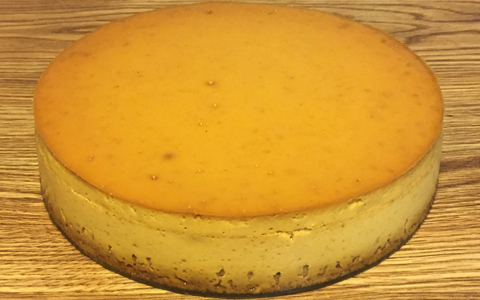
Baked Pumpkin Cheesecake—Prototype 12:
3-Cheese Blend (1CT-1NC-1YG):
Prepare ahead of time 16 ounces of yogurt cheese, derived from one 32-ounce
container of nonfat yogurt. If the resulting yogurt cheese falls below 16
ounces, add back enough of the whey (that was strained out from the yogurt) to
make up the difference. To this yogurt cheese combine 16 ounces of whipped,
lowfat cottage cheese and 16 ounces (two 8-ounce packages) of softened
Neufchatel cheese ("light cream cheese").
Grease a 9 1/2" (or 9") springform pan, but do not wrap foil around it
yet (see below).
Crust:
2 oz. melted, white chocolate
4 oz. pumpkin butter (such as from Trader Joe's)
8 oz. (1 cup) 3-cheese blend (see above)
2 tablespoons granulated sugar
2 tablespoons brown sugar
1/2 teaspoon vanilla
2 oz. All-Bran, ground up
Place the resulting mixture in the greased pan and pre-bake without tub at 300
degrees for 25 minutes, then cool enough to comfortably touch at least the
pan's upper sidewall.
Batter:
1 cup granulated sugar
40 oz. (5 cups) 3-cheese blend (see above)
14 oz. pumpkin butter
2 teaspoons vanilla
2 1/4 teaspoons xanthan gum
6 eggs
Expect close to 8 1/2 cups of the resulting batter, but do not add this to
the pan all at once. Rather, this needs to be done in four installments.
Wrap the pan in foil just before adding the first batter installment (to minimize
the foil's disturbance and therefore its leakage risk, do not put it on any
earlier).
For each of the first three installments, gently scoop about 2 1/2 cups of
batter into the pan, fully covering the surface (here's a tip—scoop small
amounts of batter around the edge of the pan, letting this batter flow towards
the middle on its own), and then bake this pan with its contents for 25 minutes,
at 325 degrees. However, at the end of the third installment's 25 minutes, add
on another 30 minutes of baking time, but only at 300 degrees (that's a 55
minute "baking installment"—the first 25 minutes at 325 degrees
and the next 30 at 300). For these three installments here, bake with the pan in
a tub filled with at least 1/4 to 1/2 inch of boiling water, but (to reduce
spillage risks) do not fill the tub all the way at this point, because the whole
tub-and-pan assembly is going to need to be removed from the oven (in order to
comfortably add contents to the pan) between installments.
After these first three installments are done, there should be about 1 cup of
batter left, with 105 minutes of baking time reached at this point (25 minutes
for each of the first two installments, and 55 for the third one). Now comes the
fourth installment—carefully add the last of this batter on top of the
pan's earlier installments, fully coating the entire surface. Next, return the
entire pan-and-tub assembly to the oven, with the temperature remaining at 300
degrees. At this point, fill up the tub generously with boiling water. Resume
baking for another 105 minutes (based upon usage of a 9 1/2" pan).
Afterward, shut the oven off, and leave its door slightly ajar, with the
cheesecake still inside—and in the tub—for an hour. Next, remove the
cheesecake from the oven and tub. Continue to cool it down at room temperature
for another two hours. After doing so, remove the cheesecake from pan and
refrigerate.
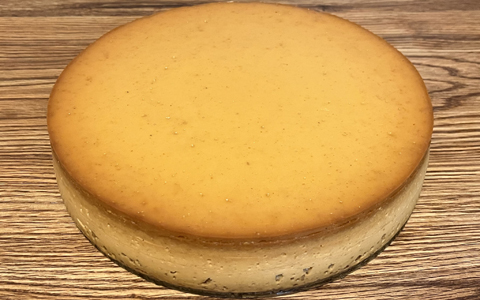
Baked Pumpkin Cheesecake—Prototype 13:
3-Cheese Blend (1CT-1NC-1YG):
Prepare ahead of time 16 ounces of yogurt cheese, derived from one 32-ounce
container of nonfat yogurt. If the resulting yogurt cheese falls below 16
ounces, add back enough of the whey (that was strained out from the yogurt) to
make up the difference. To this yogurt cheese combine 16 ounces of whipped,
lowfat cottage cheese and 16 ounces (two 8-ounce packages) of softened
Neufchatel cheese ("light cream cheese").
Grease a 9 1/2" (or 9") springform pan, but do not wrap foil around it
yet (see below).
Crust:
4 oz. melted, white chocolate
8 oz. (1 cup) 3-cheese blend (see above)
1/4 cup granulated sugar
1/4 cup brown sugar
2 teaspoons cinnamon or pumpkin pie spice
1/2 teaspoon vanilla
2 oz. All-Bran, ground up
Place the resulting mixture in the greased pan and pre-bake without tub at 300
degrees for 30 minutes, then cool enough to comfortably touch at least the
pan's upper sidewall.
Batter:
1 cup granulated sugar
40 oz. (5 cups) 3-cheese blend (see above)
14 oz. pumpkin butter
2 teaspoons vanilla
2 1/4 teaspoons xanthan gum
6 eggs
Expect close to 8 1/2 cups of the resulting batter, but do not add this to
the pan all at once. Rather, this needs to be done in four installments.
Wrap the pan in foil (or—as an alternative—use a cheesecake pan
bath wrap) just before adding the first batter installment (to minimize the
foil's disturbance and therefore its leakage risk, do not put it on any
earlier).
For each of the first three installments, gently scoop about 2 1/2 cups of
batter into the pan, fully covering the surface (here's a tip—scoop small
amounts of batter around the edge of the pan, letting this batter flow towards
the middle on its own), and then bake this pan with its contents for 30 minutes,
at 325 degrees. However, at the end of the third installment's 30 minutes, add
on another 30 minutes of baking time, but only at 300 degrees (that's a 60
minute "baking installment"—the first 30 minutes at 325 degrees
and the next 30 at 300). For these three installments here, bake with the pan in
a tub filled with at least 1/4 to 1/2 inch of boiling water, but (to reduce
spillage risks) do not fill the tub all the way at this point, because the whole
tub-and-pan assembly is going to need to be removed from the oven (in order to
comfortably add contents to the pan) between installments.
After these first three installments are done, there should be about 1 cup of
batter left, with 120 minutes of baking time reached at this point (30 minutes
for each of the first two installments, and 60 for the third one). Now comes the
fourth installment—carefully add the last of this batter on top of the
pan's earlier installments, fully coating the entire surface. Next, return the
entire pan-and-tub assembly to the oven, with the temperature remaining at 300
degrees. At this point, fill up the tub generously with boiling water. Resume
baking for another 90 minutes (based upon usage of a 9 1/2" pan).
Afterward, shut the oven off, and leave its door slightly ajar, with the
cheesecake still inside—and in the tub—for an hour. Next, remove the
cheesecake from the oven and tub. Continue to cool it down at room temperature
for another two hours. After doing so, remove the cheesecake from pan and
refrigerate.
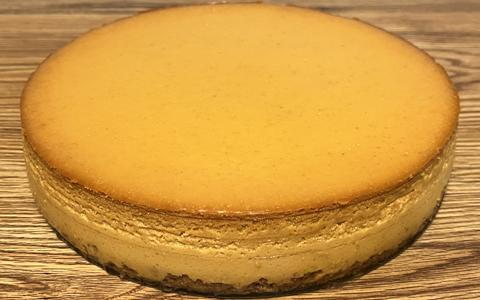
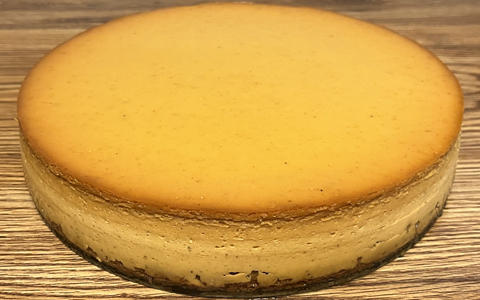
|
|

|